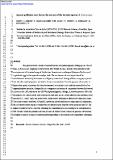Por favor, use este identificador para citar o enlazar a este item:
http://hdl.handle.net/10261/144320COMPARTIR / EXPORTAR:
 SHARE SHARE
 CORE
BASE CORE
BASE
|
|
| Visualizar otros formatos: MARC | Dublin Core | RDF | ORE | MODS | METS | DIDL | DATACITE | |

| Título: | Aquatic pollution may favor the success of the invasive species A. franciscana |
Autor: | Varó, Inmaculada CSIC ORCID; Redón, Stella CSIC ORCID; Garcia-Roger, E. M.; Amat, Francisco CSIC; Guinot, Diana CSIC; Serrano, Roque CSIC ORCID; Navarro, Juan Carlos CSIC ORCID | Palabras clave: | AChE Life tables Chlorpyrifos Artemia Invasion Toxicity |
Fecha de publicación: | abr-2015 | Editor: | Elsevier | Citación: | Aquatic toxicology 161: 208-220 (2015) | Resumen: | The genus Artemia consists of several bisexual and parthenogenetic sibling species. One of them, A. franciscana, originally restricted to the New World, becomes invasive when introduced into ecosystems out of its natural range of distribution. Invasiveness is anthropically favored by the use of cryptobiotic eggs in the aquaculture and pet trade. The mechanisms of out-competition of the autochthonous Artemia by the invader are still poorly understood. Ecological fitness may play a pivotal role, but other underlying biotic and abiotic factors may contribute. Since the presence of toxicants in hypersaline aquatic ecosystems has been documented, our aim here is to study the potential role of an organophosphate pesticide, chlorpyrifos, in a congeneric mechanism of competition between the bisexual A. franciscana (AF), and one of the Old World parthenogenetic siblings, A. parthenogenetica (PD). For this purpose we carried out life table experiments with both species, under different concentrations of the toxicant (0.1, 1 and 5. μg/l), and analyzed the cholinesterase inhibition at different developmental stages. The results evidence that both, AF and PD, showed an elevated tolerance to high ranges of chlorpyrifos, but AF survived better and its fecundity was less affected by the exposure to the pesticide than that of PD. The higher fecundity of AF is a selective advantage in colonization processes leading to its establishment as NIS. Besides, under the potential selective pressure of abiotic factors, such as the presence of toxicants, its higher resistance in terms of survival and biological fitness also indicates out-competitive advantages. © 2015 | Versión del editor: | https://doi.org/10.1016/j.aquatox.2015.02.008 | URI: | http://hdl.handle.net/10261/144320 | DOI: | 10.1016/j.aquatox.2015.02.008 | Identificadores: | issn: 1879-1514 |
| Aparece en las colecciones: | (IATS) Artículos |
Ficheros en este ítem:
| Fichero | Descripción | Tamaño | Formato | |
|---|---|---|---|---|
| Aquatic pollution may favor the success of the invasive specie-Varo et al 2015.pdf | 808,13 kB | Adobe PDF |  Visualizar/Abrir |
CORE Recommender
SCOPUSTM
Citations
26
checked on 21-abr-2024
WEB OF SCIENCETM
Citations
23
checked on 22-feb-2024
Page view(s)
269
checked on 24-abr-2024
Download(s)
223
checked on 24-abr-2024
Google ScholarTM
Check
Altmetric
Altmetric
Este item está licenciado bajo una Licencia Creative Commons

